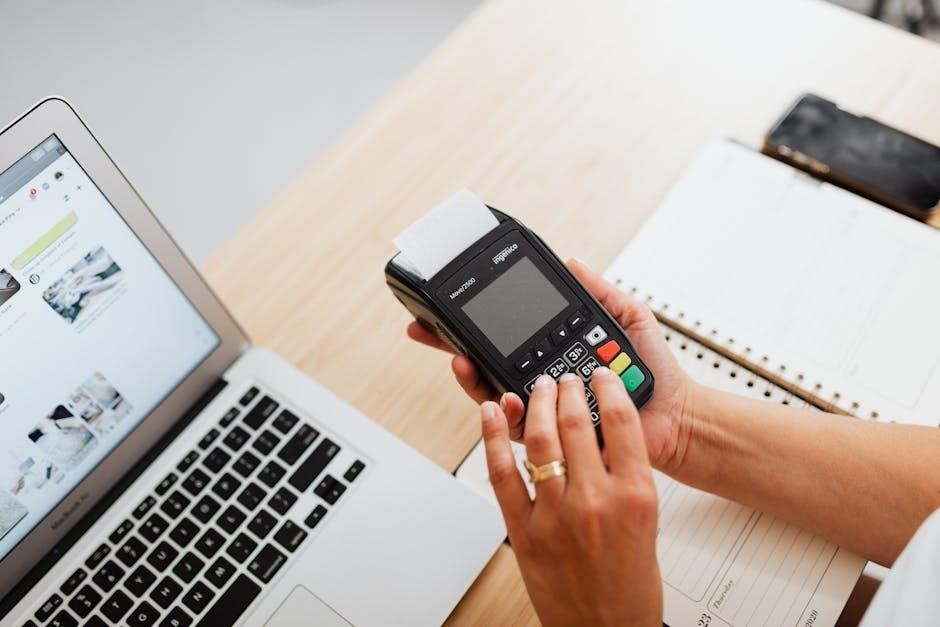1.1 Definition and Overview
A guided signature is a method for creating electronic signatures through structured workflows, ensuring documents are signed correctly and efficiently, enhancing digital documentation processes globally.
A guided signature refers to a structured method for creating electronic signatures, ensuring documents are signed efficiently and correctly. It involves predefined workflows that guide users through the signing process, reducing errors and enhancing compliance. This approach is particularly valuable in digital documentation, where accuracy and security are paramount. Guided signatures often integrate with tools like AdobeSign and Legito BioSign, enabling users to apply manuscript signatures using digital pens or tablets. By streamlining the signing process, guided signatures improve productivity and ensure that all necessary steps are followed, making them indispensable in industries requiring secure and reliable document authentication.
1.2 Importance in Digital Documentation
Guided signatures play a crucial role in streamlining digital documentation by ensuring that signing processes are efficient, secure, and compliant with legal standards. They eliminate the need for physical paperwork, reducing costs and environmental impact while accelerating document turnaround times. By providing a structured workflow, guided signatures minimize errors and ensure that all necessary parties sign in the correct order. This level of organization is particularly vital in industries like real estate, healthcare, and finance, where documentation requires precision and adherence to regulations. The integration of tools like AdobeSign and Legito BioSign further enhances the seamless execution of guided signatures, making them indispensable in modern digital workflows.
Additionally, guided signatures enhance user experience by offering clear instructions and reducing ambiguity, ensuring that signatories understand their roles and the significance of their signatures. This clarity fosters trust and confidence in digital transactions, making guided signatures a cornerstone of efficient and secure document management systems.

Types of Electronic Signatures
Electronic signatures encompass digital signatures, e-signatures, and handwritten digital versions, each offering unique features for authentication and document verification in various industries and legal frameworks.
2.1 Digital Signatures
Digital signatures are cryptographic stamps that authenticate the sender and ensure a document’s integrity; They use asymmetric cryptography, creating a hash of the document that is encrypted with the sender’s private key. This process ensures that any tampering is detectable, as the hash will not match the altered content. Digital signatures are widely recognized for their security and are often used in legal, financial, and healthcare sectors. They provide non-repudiation, meaning the sender cannot deny signing the document. Platforms like Legito BioSign integrate digital signatures, allowing users to sign documents with digital pens on tablets. This method is not only secure but also efficient, streamlining workflows in modern digital documentation.
2.2 Electronic Signatures (e-Signatures)
Electronic signatures, or e-signatures, are digital methods used to validate and confirm the authenticity of a document. They encompass a broad range of techniques, including typed names, click-to-sign buttons, and scanned images of handwritten signatures. E-signatures are widely adopted in industries like real estate, finance, and healthcare due to their convenience and legal enforceability. Platforms such as AdobeSign and Legito BioSign offer seamless integration, enabling users to apply e-signatures directly within documents. Unlike digital signatures, e-signatures do not necessarily use encryption but still provide a secure and efficient way to execute agreements. Their adoption has streamlined workflows, reducing the need for physical paperwork and accelerating document processing globally.
2.3 Handwritten vs. Digital Signatures
Handwritten signatures are traditional and widely recognized, offering a personal touch and legal validity in many contexts. Digital signatures, on the other hand, use cryptographic methods like encryption and hashing to ensure document authenticity and integrity. While handwritten signatures are familiar, digital signatures provide enhanced security, making them ideal for sensitive transactions. Tools like Legito BioSign allow users to apply manuscript signatures digitally, bridging the gap between traditional and modern methods. Both types are legally binding, but digital signatures offer additional layers of verification, reducing fraud risks. As technology advances, digital signatures are increasingly preferred for their efficiency and security, though handwritten signatures remain relevant in certain scenarios.

Technology Behind Guided Signatures
Guided signatures rely on encryption, hashing, and asymmetric cryptography to ensure document integrity and authenticity, streamlining workflows and enhancing security in digital transactions.
3.1 Cryptographic Methods and Encryption
Cryptographic methods and encryption form the backbone of guided signatures, ensuring secure and authentic digital transactions. These technologies use advanced algorithms to protect data integrity and confidentiality. Encryption transforms sensitive information into unreadable formats, while cryptographic hashing creates unique digital fingerprints for verification. Together, they ensure that signed documents cannot be altered without detection, maintaining the integrity of the signature process. Certificate-based systems further enhance security by verifying the identity of signatories. These methods are essential for preventing tampering and ensuring compliance with legal standards, making guided signatures a reliable choice for sensitive documentation across industries.
3.2 Asymmetric Cryptography and Hashing
Asymmetric cryptography and hashing are pivotal in securing guided signatures, ensuring their authenticity and integrity. Asymmetric cryptography uses a private key for signing documents and a public key for verification, providing a secure method for digital signatures. Hashing creates a unique digital fingerprint of the document, ensuring that any post-signature alterations are detectable. This dual-layered security ensures that signed documents remain tamper-proof and authentic. These technologies are essential for compliance with legal standards and are widely applied in industries requiring high-security documentation. By integrating asymmetric cryptography and hashing, guided signatures offer a reliable and secure solution for digital transactions.
3.3 Biometric Authentication in Signatures
Biometric authentication in guided signatures enhances security by using unique biological traits, such as fingerprints or facial recognition, to verify signers’ identities. This method ensures non-repudiation, as biometric data is distinct to individuals. The integration of biometrics with digital signatures creates a robust authentication process, reducing fraud risks. Advanced algorithms analyze biometric inputs in real-time, ensuring accuracy and efficiency. This technology is particularly valuable in sensitive sectors like healthcare and finance, where secure and reliable authentication is critical. By combining biometric verification with cryptographic techniques, guided signatures achieve unparalleled security levels, protecting digital documents from unauthorized access and ensuring compliance with stringent regulatory requirements. This approach represents a significant advancement in secure digital signature solutions.

Use Cases for Guided Signatures
Guided signatures streamline workflows in legal, financial, healthcare, and real estate sectors by ensuring secure and efficient document signing, enhancing compliance and user experience across industries globally.
4.1 Legal and Financial Documents
Guided signatures play a pivotal role in legal and financial documentation by ensuring accuracy and compliance. They facilitate secure and efficient signing of contracts, agreements, and transactions, reducing errors and enhancing trust. Industries like law, finance, and real estate benefit from streamlined workflows, with tools like Legito BioSign and AdobeSign enabling manuscript signatures via digital pens. This technology ensures authenticity and integrity, making it indispensable for sensitive legal and financial processes. The integration of guided signatures with document management systems further accelerates turnaround times, ensuring seamless operations and maintaining regulatory compliance across these critical sectors.
4.2 Healthcare and Insurance Industries
Guided signatures are transforming the healthcare and insurance sectors by streamlining document workflows and ensuring compliance. In healthcare, they enable secure signing of patient forms, consent documents, and medical records, reducing administrative burdens. Insurance companies benefit from efficient processing of claims, policies, and applications, enhancing customer satisfaction. The use of digital tools like Legito BioSign and AdobeSign integrates seamlessly with existing systems, ensuring accuracy and reducing errors. This technology also supports biometric authentication, adding an extra layer of security for sensitive medical and financial data.
The adoption of guided signatures in these industries not only improves operational efficiency but also strengthens data integrity, making it a critical tool for modern healthcare and insurance operations.
4.3 Real Estate Transactions
Guided signatures play a pivotal role in streamlining real estate transactions by enabling secure and efficient document signing. From property contracts to lease agreements, this technology ensures all parties can sign documents remotely, reducing delays and enhancing convenience. The use of platforms like Legito BioSign and AdobeSign allows for seamless integration with existing real estate management systems, ensuring accuracy and compliance. Real estate professionals can easily guide clients through the signing process, reducing paperwork and errors. This method also supports biometric authentication, adding an extra layer of security for high-stakes transactions. As a result, guided signatures are revolutionizing the real estate industry, making transactions faster, more secure, and client-friendly.

Security and Authentication
Guided signatures use cryptographic methods and biometric authentication to ensure document integrity and protect sensitive data.
5.1 Ensuring Integrity and Authenticity
Guided signatures employ advanced cryptographic methods and encryption to ensure document integrity and authenticity. By using hashing algorithms, a unique fingerprint of the document is created, detecting even minor alterations. Certificate-based systems further verify the signatory’s identity, ensuring that only authorized individuals can sign. This dual-layered security prevents tampering and guarantees the document’s authenticity. The combination of encryption and biometric authentication adds an extra layer of protection, making it nearly impossible for unauthorized parties to alter the document without detection. These technologies collectively safeguard sensitive information and maintain the legal enforceability of digitally signed documents across various industries.
5.2 Tamper-Proof Mechanisms
Tamper-proof mechanisms in guided signatures ensure that any unauthorized alterations to a document are immediately detectable. These mechanisms rely on cryptographic hashing, which creates a unique digital fingerprint of the document. If the content is modified, the hash value changes, signaling tampering. Additionally, asymmetric cryptography ensures that the signature is tied to the specific document, making it impossible to transfer or replicate without detection. Biometric authentication further enhances security by linking the signature to the individual’s unique traits; These technologies collectively create a robust system where any attempt to alter the document breaks the cryptographic seal, ensuring the integrity of the signed document remains intact and verifiable.
5.3 Certificate-Based Systems
Certificate-based systems in guided signatures use digital certificates to authenticate and verify the identity of signatories. These certificates, issued by trusted Certificate Authorities (CAs), contain the signer’s public key and identity details. When a document is signed, the system generates a hash of the document, encrypts it with the signer’s private key, and attaches the certificate. This ensures that the signature cannot be forged, as the public key from the certificate can decrypt the hash, confirming the signer’s identity. Revocation lists are used to invalidate compromised certificates, ensuring ongoing security. These systems are widely trusted and integrate seamlessly with document management platforms like AdobeSign, offering robust verification and authentication for guided signatures in legal and financial contexts.

Legal and Regulatory Considerations
Guided signatures must comply with global regulations like eIDAS and E-SIGN Act, ensuring legal validity and court admissibility across jurisdictions.
6.1 Global Regulations and Compliance
Guided signatures must adhere to global regulations such as the EU’s eIDAS and the US E-SIGN Act, ensuring legal validity and security. These frameworks require encryption, authentication, and tamper-proof mechanisms to maintain compliance. Non-compliance can result in legal repercussions, emphasizing the importance of understanding regional variations in digital signature laws. Businesses must stay updated on jurisdiction-specific requirements to ensure seamless integration of guided signatures across international markets while avoiding potential penalties or document rejection. Proper implementation of these standards ensures that guided signatures remain legally binding and widely accepted, fostering trust and efficiency in global transactions. Compliance is critical for maintaining integrity and authenticity in digital documentation processes worldwide.
6.2 Regional Variations in Digital Signature Laws
Regional variations in digital signature laws require careful consideration. For instance, the EU’s eIDAS regulation mandates advanced electronic signatures for legal validity, while the US E-SIGN Act allows broader acceptance of electronic signatures. In contrast, countries like India require digital signatures to be based on specific cryptographic standards under the IT Act. These regional differences impact cross-border transactions, as businesses must ensure compliance with local laws. Understanding these variations is crucial for maintaining legal validity and avoiding disputes. Non-compliance can lead to rejected documents or legal challenges, emphasizing the need for tailored solutions. Staying informed about jurisdiction-specific requirements ensures seamless integration of guided signatures across diverse markets while respecting local regulations. This variability underscores the complexity of global digital documentation practices.
6.3 Court Admissibility of Digital Signatures
Digital signatures are widely accepted in courts due to their cryptographic underpinnings, which ensure authenticity and integrity. Courts recognize digital signatures as valid evidence under laws like the E-SIGN Act in the U.S. and eIDAS in the EU. The use of asymmetric cryptography and hashing creates a tamper-proof record, making it difficult to dispute the legitimacy of a digitally signed document. Certificate-based systems further enhance credibility by linking the signature to the signer’s identity. Judges often rely on these technical safeguards to admit digital signatures as evidence, ensuring legal proceedings remain efficient and secure. This acceptance highlights the transformative role of guided signatures in modern legal frameworks, streamlining documentation while upholding judicial standards. The integrity provided by encryption makes digital signatures a trusted tool in courtrooms worldwide.

Integration with Document Management Systems
Guided signatures seamlessly integrate with document management systems (DMS), enhancing workflow efficiency. AdobeSign and Legito BioSign enable users to apply manuscript signatures via digital pens and tablets, ensuring compatibility with Microsoft Office and cloud-based platforms. These tools streamline signing processes, reduce manual work, and automate document workflows, ensuring secure and efficient integration with existing systems. The use of encryption and authentication protocols guarantees document integrity and compliance with regulatory standards, making guided signatures a reliable choice for organizations seeking to modernize their document management practices while maintaining high levels of security and user satisfaction.
7.1 AdobeSign and Legito BioSign Integration
AdobeSign and Legito BioSign integrate seamlessly with guided signature workflows, enabling users to apply manuscript signatures via digital pens and tablets. These tools streamline document signing processes, ensuring compatibility with Microsoft Office and cloud-based platforms. Legito BioSign enhances security by using biometric authentication, while AdobeSign provides robust encryption and certificate-based systems. Together, they simplify workflows, reduce manual tasks, and ensure compliance with regulatory standards. This integration is particularly valuable in industries like finance, insurance, and real estate, where secure and efficient document management is critical. By combining advanced signature technology with document management systems, AdobeSign and Legito BioSign deliver a user-friendly experience while maintaining high levels of security and compliance.
7.2 Microsoft Word and Excel Compatibility
Guided signatures are fully compatible with Microsoft Word and Excel, allowing seamless integration into document workflows. Users can easily create and manage contracts using Word templates, while Excel data can be dynamically imported to populate forms. This compatibility enhances efficiency, enabling businesses to maintain their existing document management processes. The integration supports industries like legal, finance, and real estate, where precise document formatting and data accuracy are critical. By leveraging Microsoft Office tools, guided signature solutions ensure smooth transitions for organizations already relying on these platforms. This compatibility underscores the versatility of guided signatures in streamlining workflows without disrupting familiar software environments.
7.3 Cloud-Based Signature Platforms
Cloud-based signature platforms have revolutionized the way guided signatures are implemented, offering scalable and accessible solutions for businesses. These platforms enable users to sign documents remotely, eliminating the need for physical meetings. They are highly secure, using encryption and biometric authentication to ensure authenticity. Cloud-based systems are cost-effective, reducing the need for hardware and software installations. Platforms like Certinal and Legito BioSign provide seamless integration with popular tools, allowing businesses to maintain efficient workflows. These solutions are particularly beneficial for industries requiring frequent document signing, such as real estate and healthcare. Cloud-based platforms also offer real-time tracking and audit trails, enhancing transparency and compliance with legal standards.

Best Practices for Implementation
Implementing guided signatures requires robust user authentication, ensuring data integrity, and selecting tools that align with organizational needs and compliance standards for secure and efficient workflows.
8.1 User Authentication and Authorization
Effective user authentication and authorization are critical for secure guided signature processes. Multi-factor authentication ensures only authorized individuals can access and sign documents, reducing fraud risks. Role-based access control further enhances security by limiting signature capabilities to specific users or groups. Biometric verification, such as fingerprint or facial recognition, adds an extra layer of authenticity. Authorization protocols must align with organizational policies and legal requirements, ensuring compliance with regulations like GDPR and eIDAS. Regular audits and updates to authentication mechanisms are essential to maintain security and adapt to emerging threats. By combining robust authentication with clear authorization frameworks, businesses can ensure the integrity and legality of their digital signature workflows.
8.2 Data Integrity and Privacy
Ensuring data integrity and privacy is paramount in guided signature processes. Encryption and hashing technologies safeguard documents from unauthorized access and tampering. Secure socket layer (SSL) protocols protect data transmission, while access controls restrict document visibility to authorized personnel only. Compliance with regulations like GDPR and CCPA is essential to maintain user trust and avoid legal penalties. Anonymization techniques can further protect sensitive information, ensuring personal data remains confidential. Regular security audits and updates to encryption methods help mitigate potential vulnerabilities. By prioritizing data integrity and privacy, organizations can build a secure and reliable guided signature system that respects user confidentiality and maintains the highest standards of data protection.
8.3 Choosing the Right Signature Tool
Selecting the appropriate guided signature tool is crucial for seamless document workflows. Consider tools that integrate with popular platforms like AdobeSign and Microsoft Office for compatibility. Ensure the tool supports biometric authentication for enhanced security. Cloud-based solutions offer scalability and accessibility, while on-premise options provide control over data storage. Evaluate features like real-time notifications, audit trails, and multi-factor authentication to streamline processes. Compliance with industry standards, such as GDPR and eIDAS, is essential for legal validity. User-friendly interfaces and customizable templates can improve adoption rates. Finally, assess customer support and scalability to ensure the tool aligns with your organization’s current and future needs, fostering efficiency and trust in your digital signature processes.

Future Trends in Guided Signatures
AI-driven verification, blockchain integration, and cross-platform compatibility are expected to enhance guided signature systems, ensuring security, transparency, and accessibility across diverse digital platforms and devices.
9.1 AI-Driven Signature Verification
AI-driven signature verification is revolutionizing the guided signature process by enhancing accuracy and security. Advanced machine learning algorithms analyze signature patterns, detecting even subtle forgeries. This technology integrates seamlessly with existing systems, enabling real-time verification and reducing fraud. AI also automates the validation process, minimizing human error and increasing efficiency. With the ability to learn from large datasets, AI systems improve over time, adapting to new threats and ensuring robust security. This innovation is particularly valuable in legal and financial sectors, where document authenticity is critical. By combining AI with cryptographic methods, guided signatures become more reliable and secure, setting a new standard for digital authentication.
9.2 Blockchain for Enhanced Security
Blockchain technology is emerging as a powerful tool to enhance the security of guided signatures. By integrating blockchain, each signed document is hashed and stored on a decentralized ledger, ensuring tamper-proof records. This immutable storage prevents unauthorized modifications, as any alteration would disrupt the blockchain’s integrity. Decentralization also reduces reliance on a single server, minimizing vulnerabilities to cyber-attacks. Blockchain’s transparency allows all parties to verify document authenticity, fostering trust in digital transactions. This technology is particularly transformative for legal and financial sectors, where document integrity is paramount. As blockchain continues to evolve, it promises to revolutionize guided signatures by offering unparalleled security and reliability, making it a cornerstone of future digital authentication systems.
9.3 Cross-Platform Compatibility
Cross-platform compatibility is a critical trend in guided signatures, enabling seamless integration across various operating systems, devices, and document management systems. This ensures that users can sign documents effortlessly, whether on desktops, tablets, or mobile devices. Compatibility with popular platforms like AdobeSign, Microsoft Word, and cloud-based systems enhances accessibility and convenience. As businesses operate in diverse environments, cross-platform compatibility streamlines workflows and fosters collaboration. It also supports global adoption, as organizations can use guided signatures regardless of their technological setup. This feature is essential for modern digital documentation, ensuring that guided signatures remain versatile and adaptable to evolving technological landscapes, making them indispensable in a interconnected world.
Guided signatures offer a secure, efficient, and legally compliant way to authenticate digital documents, revolutionizing industries with enhanced security, efficiency, and global adoption.
10.1 Summary of Key Points

Guided signatures streamline digital workflows, ensuring security and compliance. They utilize cryptographic methods and biometric authentication to guarantee document integrity and signer authenticity. Integration with tools like AdobeSign and Legito enhances efficiency, while global regulations ensure legal acceptance. By simplifying complex processes, guided signatures foster faster document execution across industries, from finance to healthcare. Their tamper-proof nature and certificate-based systems build trust, making them indispensable in modern digital transactions. As technology evolves, guided signatures will continue to play a pivotal role in secure, efficient, and legally binding digital documentation.
10.2 The Future of Digital Signatures
The future of digital signatures is poised for transformation with advancements in AI, blockchain, and biometric technologies. AI-driven verification will enhance accuracy and accessibility, while blockchain will offer unparalleled security and transparency. Cross-platform compatibility will simplify workflows, enabling seamless integration across devices and systems. As regulations evolve, digital signatures will become the standard for global transactions, reducing paperwork and accelerating processes. The integration of guided signature tools with emerging technologies promises to revolutionize industries, ensuring secure, efficient, and legally binding digital interactions. This evolution will not only enhance user experience but also strengthen trust in digital documentation, paving the way for a more connected and streamlined future.



